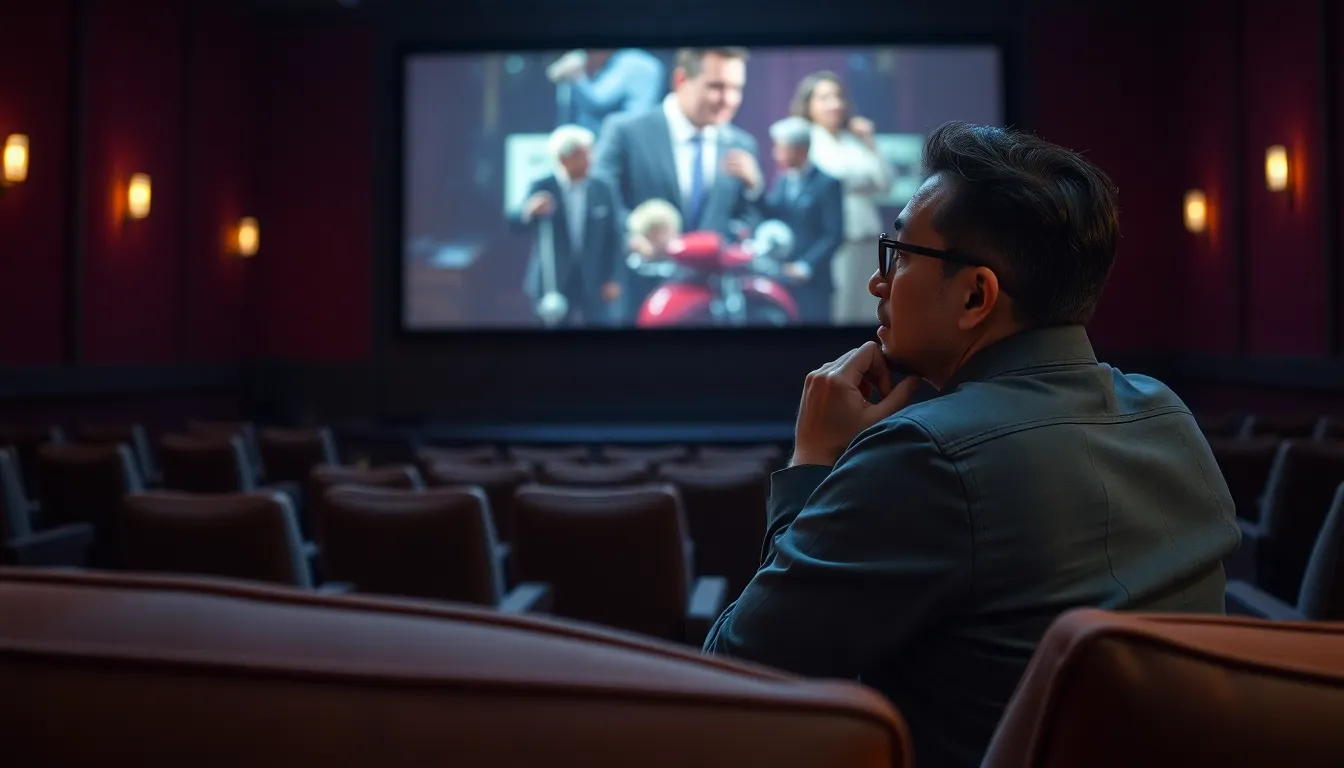Table of Contents
ToggleMovies have a magical way of transporting viewers to different worlds, but what if there’s more to them than meets the eye? Dive into the fascinating realm of movie interpretation where every frame can spark a debate, and every plot twist can lead to a new theory. Whether it’s a heartwarming rom-com or a mind-bending sci-fi thriller, the way a film is interpreted can reveal hidden layers of meaning that even the director might not have intended.
Imagine sitting in a theater, popcorn in hand, and suddenly realizing the protagonist’s journey mirrors your own life struggles. It’s not just entertainment; it’s a reflection of society, culture, and even personal experiences. So grab your 3D glasses and a sense of humor as we explore the art of deciphering films, because understanding a movie might just be the best plot twist of all.
Understanding Movie Interpretation
Movie interpretation involves analyzing and decoding the meanings within films. Each viewer’s perspective shapes their understanding, making interpretation a subjective yet rewarding process.
Definition of Movie Interpretation
Movie interpretation represents the process of deriving meaning from a film’s narrative, dialogue, visuals, and themes. It encompasses analyzing elements like character motivations, symbolism, and cultural context. Context influences interpretation, allowing viewers to connect personal experiences with cinematic content. Different genres may evoke unique reactions and understandings. For instance, a horror film might reflect societal fears, while a romantic comedy may explore human relationships.
Importance in Film Studies
Importance in film studies lies in its ability to deepen understanding of cultural and social issues embedded in cinema. Analysis helps scholars explore how films reflect historical contexts and societal norms. Education across disciplines, like psychology and sociology, benefits from movie interpretation. Engaging with films critically fosters analytical skills and encourages thoughtful discourse. Films serve not just as entertainment but as tools for education and reflection, prompting discussions about identity, morality, and human nature. Engaging with movie interpretation transforms simple viewership into an enriching exploration of art.
Key Elements of Movie Interpretation

Understanding key elements enhances the appreciation of film, revealing complexities beyond viewing. This section explores themes and motifs as well as character analysis in movie interpretation.
Themes and Motifs
Films communicate universal themes that resonate deeply with audiences. Common motifs like love, loss, or redemption appear across various stories, offering insights into human experience. Differentiating between surface narratives and underlying messages allows viewers to uncover richer meanings. For instance, a recurring visual symbol might connect disparate plotlines, enriching the audience’s understanding of the film’s core message. Analyzing themes leads to discussions about societal issues and personal reflections, enhancing the viewer’s engagement with the movie.
Character Analysis
Character arcs play a vital role in movie interpretation. Each character’s motivations drive the plot and provide key insights into their development. Observing how characters respond to challenges reveals their complexities and personal growth. Conflicts they face often reflect larger societal issues, encouraging viewers to empathize with their struggles. Distinct personalities can shape how audiences perceive themes, ultimately influencing their interpretation of the story. Engaging with character analysis invites viewers to explore deeper emotional landscapes, making the viewing experience more impactful.
Approaches to Movie Interpretation
Different methodologies exist for interpreting films, each offering unique insights into their narratives and themes. Two of the most prominent approaches include the psychological and sociocultural perspectives.
Psychological Approach
The psychological approach focuses on the mental and emotional states of characters. It examines how psychological theories, such as Freudian concepts, manifest within narratives. Character motivations often reveal deeper layers of trauma, desire, and conflict. For instance, a character’s obsession might illustrate underlying psychological issues, enriching the viewer’s understanding. Audiences may resonate with emotionally charged scenes that reflect inner struggles, leading to profound connections with the story.
Sociocultural Approach
The sociocultural approach analyzes films within their broader social and cultural contexts. This perspective considers factors like class, race, and gender dynamics. It enables viewers to comprehend how societal influences shape character behavior and plot development. Films often mirror cultural norms or challenge societal constructs, prompting discussions on contemporary issues. By exploring these contexts, audiences gain insights into themes like identity and power, nourishing a deeper appreciation for the film’s commentary on life.
Common Pitfalls in Movie Interpretation
Several common pitfalls hinder effective movie interpretation. Recognizing these obstacles enhances comprehension and enriches the viewing experience.
Misinterpretation of Symbols
Symbolism plays a significant role in conveying deeper meanings within films. Viewers often misinterpret symbols, leading to inaccurate conclusions. For instance, a recurring object like a broken mirror might represent fractured identity rather than simply reflecting the character’s physical appearance. Familiarity with common symbols can aid viewers in deciphering intended messages. Understanding that symbols may vary in meaning across different cultures improves clarity. Ultimately, careful analysis of context surrounding symbols helps in avoiding the trap of misinterpretation.
Overlooking Cultural Context
Cultural context informs many films and their narratives. Many viewers neglect this essential element, missing vital insights. Viewing a movie without considering its cultural background can lead to misunderstanding character motivations or plot developments. For example, films made in specific historical periods often reflect societal norms, thereby impacting character actions. Acknowledging the cultural influences enhances appreciation of the film’s themes. Engaging with a film’s cultural context fosters a deeper connection and facilitates rich discussions on relevant issues.
Movie interpretation opens a world of possibilities for viewers. By engaging with the nuances of film, individuals can uncover layers of meaning that resonate on personal and societal levels. Each interpretation enriches the viewing experience and fosters deeper connections with the art form.
As audiences explore themes and character dynamics, they not only enhance their understanding but also contribute to broader conversations about culture and identity. This journey through cinema invites curiosity and critical thinking, transforming passive watching into an active exploration of human experiences. Embracing the art of movie interpretation allows viewers to appreciate films as more than mere entertainment, but as reflections of life itself.



